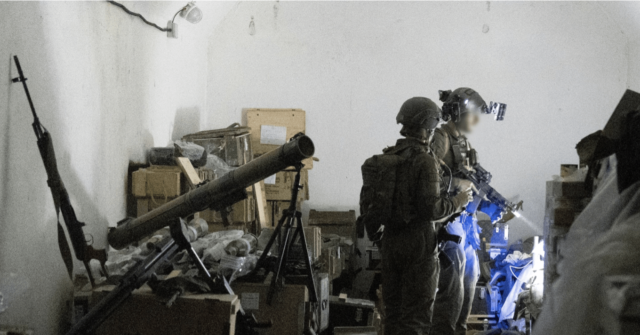On Saturday, the Israel Defense Forces (IDF) disclosed the discovery of a substantial underground tunnel, posited to be used for orchestrating attacks similar to the one executed on October 7, 2023. This tunnel, located in a residential area near the Israeli-Lebanese border, is believed to be a Hezbollah construction and was unveiled to Israeli journalists by IDF officials during a tour. The tunnel spans 1.5 kilometers and could house hundreds of combatants, indicating its strategic significance for potential military operations against Israel.
The IDF revealed that the tunnel’s entry was situated in the backyard of a private home in southern Lebanon, which suggests a calculated effort by Hezbollah to conceal military operations within civilian infrastructure. According to reports, the IDF had been conducting intensive operations in the mountainous and subterranean regions of southern Lebanon for approximately a month to counter Hezbollah and its threats. The discovery of the tunnel underscores the ongoing tension and conflict between Israel and Hezbollah, reflecting the militaristic strategies employed by both sides in the volatile region.
Brigadier General Guy Levy from the IDF’s 98th Division led a small group of journalists to witness the tunnel prior to its destruction, highlighting the IDF’s proactive approach in informing the public and the media about their findings and military engagements. The underground facility not only served as a hidden passage but also functioned as a military base equipped with supplies that could sustain fighters for lengthy periods. Essential amenities such as beds, food storage, electricity, and a wide array of weaponry—including anti-tank missiles and explosive devices—were stored within, indicating the depth of preparation by Hezbollah for potential aggression against Israel.
The operation to uncover and neutralize the tunnel was a collaborative effort involving multiple IDF divisions, including specialized units trained for subterranean warfare. During the operation, IDF troops encountered entrenched militants who posed immediate threats, resulting in close-quarter confrontations that ultimately led to the elimination of enemy combatants. This level of engagement emphasizes the ongoing nature of this conflict, as both parties remain committed to asserting their military capabilities, with Hezbollah launching attacks that have prompted significant civilian evacuations within Israel.
The strategic importance of the tunnel highlights the precarious security situation for Israel, particularly as Hezbollah has escalated attacks on northern Israeli territories over the last year. The IDF’s operations reflect a response not only to these immediate threats but also to a broader geopolitical landscape characterized by persistent conflict and the need for stringent defense measures. The evacuation of over 60,000 residents from their homes indicates the impact of this ongoing strife on civilian life and safety, reflecting the pervasive fear and instability in the region.
Following the destruction of the tunnel, seismic alerts were registered in northern Israel, demonstrating the substantial impact of military operations and the physical remnants of conflict in the area. This incident illustrates the complexities involved in the Israeli-Lebanese border conflict, where military actions have both immediate and lasting repercussions on the land and its people. As the IDF continues its operations against Hezbollah, the underlying tensions will likely persist, serving as a reminder of the region’s enduring volatility.

